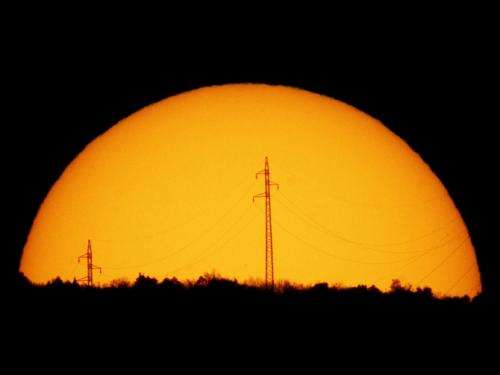Getting ready for the next big solar storm

(PhysOrg.com) -- In Sept. 1859, on the eve of a below-average1 solar cycle, the sun unleashed one of the most powerful storms in centuries. The underlying flare was so unusual, researchers still aren't sure how to categorize it. The blast peppered Earth with the most energetic protons in half-a-millennium, induced electrical currents that set telegraph offices on fire, and sparked Northern Lights over Cuba and Hawaii.
This week, officials have gathered at the National Press Club in Washington DC to ask themselves a simple question: What if it happens again?
"A similar storm today might knock us for a loop," says Lika Guhathakurta, a solar physicist at NASA headquarters. "Modern society depends on high-tech systems such as smart power grids, GPS, and satellite communications--all of which are vulnerable to solar storms."
She and more than a hundred others are attending the fifth annual Space Weather Enterprise Forum—"SWEF" for short. The purpose of SWEF is to raise awareness of space weather and its effects on society especially among policy makers and emergency responders. Attendees come from the US Congress, FEMA, power companies, the United Nations, NASA, NOAA and more.
As 2011 unfolds, the sun is once again on the eve of a below-average solar cycle—at least that’s what forecasters are saying. The "Carrington event" of 1859 (named after astronomer Richard Carrington, who witnessed the instigating flare) reminds us that strong storms can occur even when the underlying cycle is nominally weak.
In 1859 the worst-case scenario was a day or two without telegraph messages and a lot of puzzled sky watchers on tropical islands.
In 2011 the situation would be more serious. An avalanche of blackouts carried across continents by long-distance power lines could last for weeks to months as engineers struggle to repair damaged transformers. Planes and ships couldn’t trust GPS units for navigation. Banking and financial networks might go offline, disrupting commerce in a way unique to the Information Age. According to a 2008 report from the National Academy of Sciences, a century-class solar storm could have the economic impact of 20 hurricane Katrinas.
As policy makers meet to learn about this menace, NASA researchers a few miles away are actually doing something about it:
"We can now track the progress of solar storms in 3 dimensions as the storms bear down on Earth," says Michael Hesse, chief of the GSFC Space Weather Lab and a speaker at the forum. "This sets the stage for actionable space weather alerts that could preserve power grids and other high-tech assets during extreme periods of solar activity."
They do it using data from a fleet of NASA spacecraft surrounding the sun. Analysts at the lab feed the information into a bank of supercomputers for processing. Within hours of a major eruption, the computers spit out a 3D movie showing where the storm will go, which planets and spacecraft it will hit, and predicting when the impacts will occur. This kind of "interplanetary forecast" is unprecedented in the short history of space weather forecasting.
These 3D Heliospheric animated models, developed by the Community Coordinated Modeling Center based at the Goddard Space Flight Center, show how the June 21, 2011 CME cloud might appear as it sweeps past Earth. Credit: NASA/CCMC
"This is a really exciting time to work as a space weather forecaster," says Antti Pulkkinen, a researcher at the Space Weather Lab. "The emergence of serious physics-based space weather models is putting us in a position to predict if something major will happen."
Some of the computer models are so sophisticated, they can even predict electrical currents flowing in the soil of Earth when a solar storm strikes. These currents are what do the most damage to power transformers. An experimental project named "Solar Shield" led by Pulkkinen aims to pinpoint transformers in greatest danger of failure during any particular storm.
"Disconnecting a specific transformer for a few hours could forestall weeks of regional blackouts," says Pulkkinen.
Another SWEF speaker, John Allen of NASA's Space Operations Mission Directorate, pointed out that while people from all walks of life can be affected by space weather, no one is out on the front lines quite like astronauts.
"Astronauts are routinely exposed to four times as much radiation as industrial radiation workers on Earth," he says. "It's a serious occupational hazard."
NASA keeps careful track of each astronaut's accumulated dosage throughout their careers. Every launch, every space walk, every solar flare is carefully accounted for. If an astronaut gets too close to the limits ... he or she might not be allowed out of the space station! Accurate space weather alerts can help keep these exposures under control by, e.g., postponing spacewalks when flares are likely.
Speaking at the forum, Allen called for a new kind of forecast: "We could use All Clear alerts. In addition to knowing when it's dangerous to go outside, we'd also like to know when it's safe. This is another frontier for forecasters--not only telling us when a sunspot will erupt, but also when it won't."
The educational mission of SWEF is key to storm preparedness. As Lika Guhathakurta and colleague Dan Baker of the University of Colorado asked in a June 17th New York Times op-ed: "What good are space weather alerts if people don’t understand them and won’t react to them?"
By spreading the word, SWEF will help.
More information about the meeting, including a complete program of speakers, may be found at the SWEF 2011 home page.
Provided by Science@NASA





















